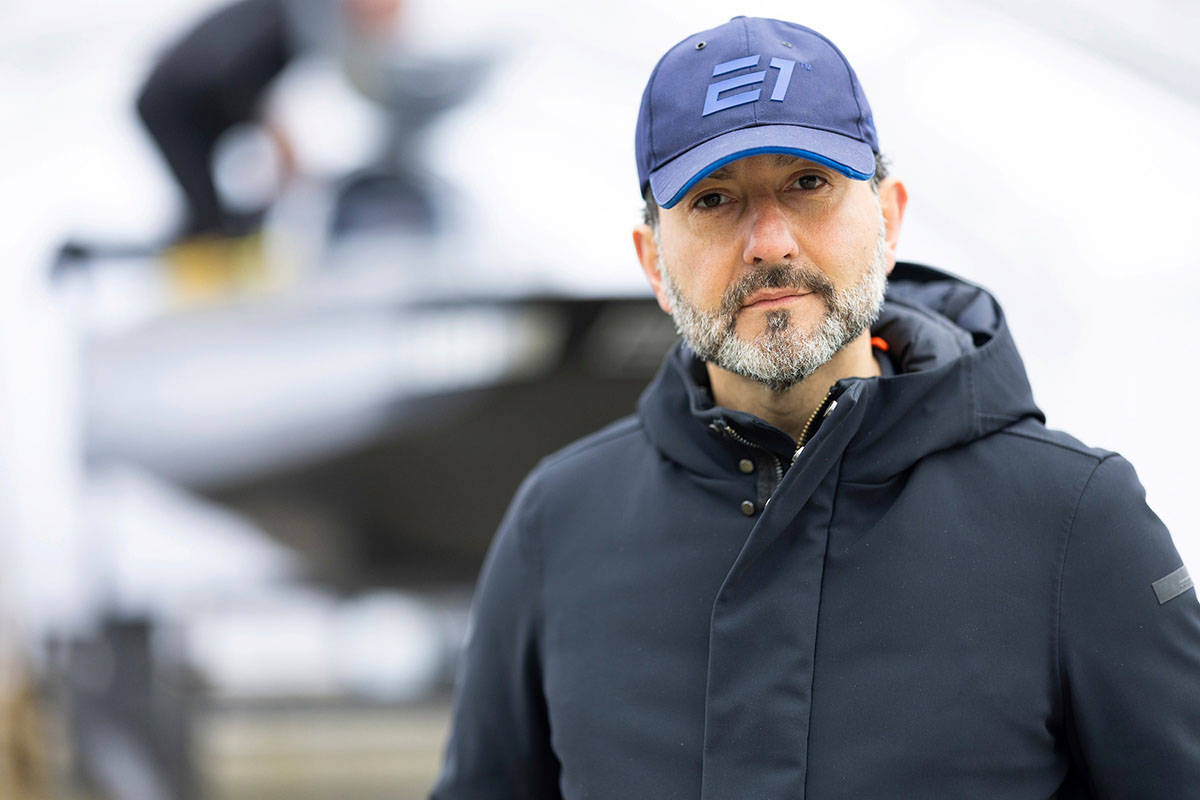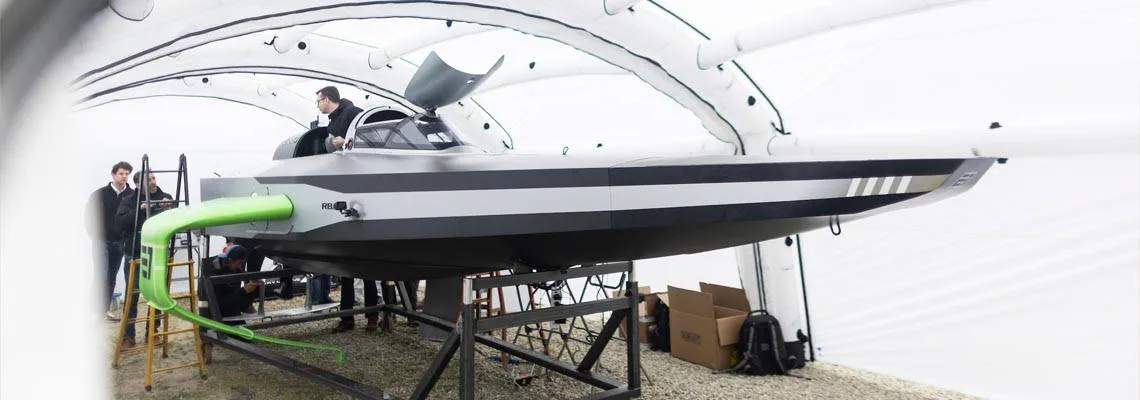The organisers and designers for the new electric powerboat E1 Series have harnessed technology from automotive and marine industries to move from concept to test hydrofoil racing boat in just eight months. We ask former NASA and F1 engineer, Rodi Basso, about lessons learned and wider implications for the marine leisure industry.
Photos by Lloyd Images

The E1 Series is on course to hold the world’s first electric powerboat racing series in 2023. It will feature identical RaceBird hydrofoil-equipped monohulls, purpose designed by SeaBird Technologies and Victory Marine to achieve nearly 50 knots for up to 40 minutes duration. The series objective is to create a competitive racing platform for 12 teams that promotes sustainable electric watercraft and reduces the environmental pressures being placed on the waters we enjoy.
The E1 Series was launched in 2020 by Alejandro Agag and Rodi Basso. Alejandro has been at the forefront of sustainable motorsport, having created two electric automotive series from scratch – Formula E and Extreme E. Rodi Basso has an impressive engineering background with NASA, then F1 working with Ferrari and Red Bull Racing before serving as managing director of McLaren Applied, the technology development arm of the performance automotive manufacturer.
In this Q&A we catch up with Rodi to ask about progress on the E1 Series, the prospects for technology transfer into leisure marine and plans for a wider public access to the programme.
What is the latest electric boat development news?
The test boat was launched during April. In the first 10 days of testing, we had it working at projected speeds. As expected, we need to improve stability and dynamics, but we have a couple of months of testing to fix this and are on track.
We had just eight months to put this all together and have minimised the risk to the project by integrating proven components from the motor sport and the high-end automotive industry. We’ve combined that with technologies and methodologies from powerboating and sailing yacht design. It’s been an interesting challenge, mixing different cultures and engineering partners, as well as dealing with issues like safely operating 600V power systems on the water.
Our success has come from making sure we had the right people and partners on board, such as SeaBird Technologies, to de-risk this project as much possible.
How much of a role will electronics play in driver assistance?
Dedicated electronics are involved in the powertrain and the management of the foils. However, RaceBird has been designed to ensure driver skill is a key aspect of performance.
We went in the direction of starting from an intrinsically stable design, rather than relying on electronics for stability. The front foil is static. The driver can control the longitudinal dynamic of the race boat by manually trimming and lifting the outboard. The computer will be doing some of the work, but driver skill and water conditions will be influential factors in success.
In addition to automotive partners, you have strategic alliances with marine businesses – how is that working?
Simrad and CMAP is supplying our navigation and dashboard technology. The latest updates of their work will be on the boat that we show this year in Venice. We are very impressed by their technology and the performance of electronics and HMI (Human Machine Interface). Similarly, within the Brunswick universe, Mercury Racing has done a fantastic job on the mechanical parts and integration of the propulsion system.
How well can the marine industry develop its own capabilities in the fast-moving push for zero emissions?
For marine equipment manufacturers, innovation through cross fertilisation is the low hanging fruit. You can see what's available in industries that are currently more advanced and examine how much you can adapt those solutions to your environment. This is the fastest way to make progress.
Our vision with the E1 Series is to take all the lessons learned from automotive and motor sport to accelerate the marine industry. But we can go further. My dream for the next generation of race boats is to get to a technology level that becomes a benchmark for the aviation and automotive industries in the areas of mobility and sustainable propulsion. This is a big plan, but I think we are backed by partners that will enable us to do that.
We would love to partner with as many strong and ambitious marine players as possible to really guarantee a solid future for the marine industry. For example, we strongly believe water mobility can fix many problems in cities, such as traffic congestion and quality of life. That’s a dream we should all aim for.
What steps does the marine leisure industry need to take for mainstream adoption of electric propulsion?
There are different stages, and it takes some time. You can buy this knowledge, but you really need to get a very deep understanding of these new technologies and the challenges related to them.
Automotive supercar manufacturers like Ferrari and Lucid Motors offer a great example of what is needed. Their CEOs not only know how to manage people but are also technically gifted and able to understand how the design and engineering mindset and philosophy must change for an electric car. Such as how you design the tyres, select the dashboard, allow for the weight sensitivity, calculate the space needed and reshuffle the components to guarantee a comfortable experience.

You need to do the same for boats. The key change from the norm on RaceBird was using a hydrofoil. It was the only way to reduce the amount of battery storage that we needed. By starting to lift the boat as it hits 10 knots, you then begin to significantly reduce resistance to acceleration. Knowing this, our focus shifted from the hull design to the dynamics and the stability of the foils.
When you have a deep understanding of the technology and have been open with the paradigms that are driving the design and engineering of the boat, the final stage is safety. It is a massive job to do all of this correctly, but that's why we built this sport platform – to demonstrate these hurdles can be overcome. We've taken big risks, but again, we are well connected with other industries that can help. We believe our achievements will potentially accelerate the marine industry by 20-30 years.
How do you think social trends will affect a need for speed in the future?
As an engineer I was trained to maximise efficiency but when I entered industry the focus was on power and top speed. I believe that social and cultural changes, especially in the younger generations, together with growing environmental awareness, will mean this paradigm of chasing speed and power will switch back to efficiency and acceleration. Efficiency will reduce impact on the planet. Acceleration will create the thrill through the dynamics of the vessel you'll be driving, rather than by noise and top speed.
What are your plans to widen public access to experiences like RaceBird?
We are designing two product lines. One is for large yacht luxury tenders. The other is a boat share fleet. We are in the concept design phase and will then undertake feasibility studies before engineering and the first prototype. It is likely to take 18 months to get to the test model. We will create a boat share reservation app and will also design digital infrastructure to enable close public engagement with the E1 Series itself.
When will the first E1 Series races be held?
We are targeting a minimum of eight races for next year, commencing in the spring. Many cities are in advanced stages of discussion. For sure, we will be in Saudi Arabia and in Monaco, with Venice and Miami likely to be part of the calendar. We are talking also with other American cities like Dallas, New Orleans and Austin, where there is incredible interest.
To learn more, visit E1 Series Website







